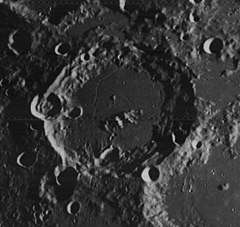Nernst (crater)
Nernst is a lunar impact crater that lies on the far side of the Moon, just beyond the northwestern limb. It lies across the northern part of the larger walled plain Lorentz, and intrudes slightly into the northwestern rim of the crater Röntgen.
 LRO mosaic | |
| Coordinates | 35.3°N 94.8°W |
|---|---|
| Diameter | 116 km |
| Depth | Unknown |
| Colongitude | 96° at sunrise |
| Eponym | Walther H. Nernst |


The rim of Nernst is relatively well-defined, although several smaller impacts lies across the edge. The satellite crater Nernst T has broken through the western rim edge. Smaller craters also lie aling the rim to the southwest and south-southeast. Around the remainder of the inner wall is some slumping and a few terrace-like features.
The interior of Nernst is relatively level, with a central peak formation offset slightly to the south of the midpoint. A pair of small craters lies on the interior floor along the western and southern inner edges. Parts of the remaining floor are marked by a series of rilles. In the southern half these rilles form grooves running generally from east to west.
Satellite craters
By convention these features are identified on lunar maps by placing the letter on the side of the crater midpoint that is closest to Nernst.
| Nernst | Latitude | Longitude | Diameter |
|---|---|---|---|
| T | 35.8° N | 96.9° W | 25 km |
References
- Andersson, L. E.; Whitaker, E. A. (1982). NASA Catalogue of Lunar Nomenclature. NASA RP-1097.CS1 maint: ref=harv (link)
- Blue, Jennifer (July 25, 2007). "Gazetteer of Planetary Nomenclature". USGS. Retrieved 2007-08-05.CS1 maint: ref=harv (link)
- Bussey, B.; Spudis, P. (2004). The Clementine Atlas of the Moon. New York: Cambridge University Press. ISBN 978-0-521-81528-4.CS1 maint: ref=harv (link)
- Cocks, Elijah E.; Cocks, Josiah C. (1995). Who's Who on the Moon: A Biographical Dictionary of Lunar Nomenclature. Tudor Publishers. ISBN 978-0-936389-27-1.CS1 maint: ref=harv (link)
- McDowell, Jonathan (July 15, 2007). "Lunar Nomenclature". Jonathan's Space Report. Retrieved 2007-10-24.CS1 maint: ref=harv (link)
- Menzel, D. H.; Minnaert, M.; Levin, B.; Dollfus, A.; Bell, B. (1971). "Report on Lunar Nomenclature by the Working Group of Commission 17 of the IAU". Space Science Reviews. 12 (2): 136–186. Bibcode:1971SSRv...12..136M. doi:10.1007/BF00171763.CS1 maint: ref=harv (link)
- Moore, Patrick (2001). On the Moon. Sterling Publishing Co. ISBN 978-0-304-35469-6.CS1 maint: ref=harv (link)
- Price, Fred W. (1988). The Moon Observer's Handbook. Cambridge University Press. ISBN 978-0-521-33500-3.CS1 maint: ref=harv (link)
- Rükl, Antonín (1990). Atlas of the Moon. Kalmbach Books. ISBN 978-0-913135-17-4.CS1 maint: ref=harv (link)
- Webb, Rev. T. W. (1962). Celestial Objects for Common Telescopes (6th revised ed.). Dover. ISBN 978-0-486-20917-3.CS1 maint: ref=harv (link)
- Whitaker, Ewen A. (1999). Mapping and Naming the Moon. Cambridge University Press. ISBN 978-0-521-62248-6.CS1 maint: ref=harv (link)
- Wlasuk, Peter T. (2000). Observing the Moon. Springer. ISBN 978-1-85233-193-1.CS1 maint: ref=harv (link)